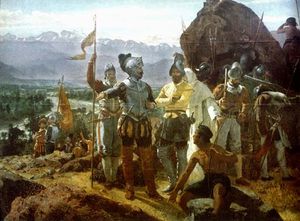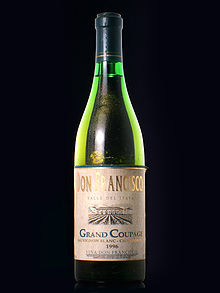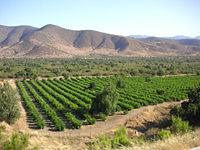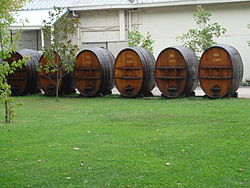- Chilean wine
-
Chilean wine is wine made in the South American country of Chile. The region has a long viticultural history for a New World wine region dating to the 16th century when the Spanish conquistadors brought Vitis vinifera vines with them as they colonized the region. In the mid-19th century, French wine varieties such as Cabernet Sauvignon and Merlot were introduced. In the early 1980s, a renaissance began with the introduction of stainless steel fermentation tanks and the use of oak barrels for aging. Wine exports grew very quickly as quality wine production increased. The number of wineries has grown from 12 in 1995 to over 70 in 2005. Chile is now the fifth largest exporter of wines in the world, and the ninth largest producer. The climate has been described as midway between that of California and France. The most common grapes are Cabernet Sauvignon, Merlot and Carmenère. So far Chile has remained free of phylloxera louse which means that the country's grapevines do not need to be grafted.[1]
Contents
History
European Vitis vinifera vines were brought to Chile by Spanish conquistadors and missionaries in the 16th century around 1554. Local legend states that the conquistador Francisco de Aguirre himself planted the first vines.[2] The vines most likely came from established Spanish vineyards planted in Peru which included the "common black grape", as it was known, that Hernán Cortés brought to Mexico in 1520. This grape variety would become the ancestor of the widely planted Pais grape that would be the most widely planted Chilean grape till the 21st century.[1] Jesuit priests cultivated these early vineyards, using the wine for the celebration of the Eucharist. By the late 16th century, the early Chilean historian Alonso de Ovalle described widespread plantings of "the common black grape", Muscatel, Torontel, Albilho and Mollar.[3]
During the Spanish rule, vineyards were restricted in production with the stipulation that the Chilean should purchase the bulk of their wines directly from Spain itself. In 1641, wine imports from Chile and the Viceroyalty of Peru into Spain were banned, severely damaging the wine industry in the colony. The market loss caused the huge surplus of grapes to be made into pisco and aguardiente. The concentration solely on pisco production, nearly eliminated wine production in Peru. For the most part the Chileans ignored these restrictions, preferring their domestic production to the oxidized and vinegary wines that didn't fare well during the long voyages from Spain. They were even so bold as to start exporting some of their wines to neighboring Peru with one such export shipment being captured at sea by the English privateer Francis Drake. When Spain heard of the event rather than being outraged at Drake, an indictment was sent back to Chile with the order to uproot most of their vineyards. This order, too, was mostly ignored.[4]
In the 18th century, Chile was known mostly for its sweet wines made from the Pais and Muscatel grapes. To achieve a high level of sweetness the wines were often boiled which concentrated the grape must.[3] Following his shipwreck off the coast at Cape Horn, Admiral John Byron (Grandfather of the poet Lord Byron) traveled across Chile and came back to England with a glowing review of Chilean Muscatel comparing it favorably to Madeira. The 19th century wine writer André Jullien was not as impressed, comparing Chilean wines to a "potion of rhubarb and senna".[4]
Despite being politically linked to Spain, Chile's wine history has been most profoundly influenced by French, particularly Bordeaux, winemaking. Prior to the phylloxera epidemic, wealthy Chilean landowners were influenced by their visits to France and began importing French vines to plant. Don Silvestre Errázuriz was the first, importing Cabernet Sauvignon, Merlot, Cabernet franc, Malbec, Sauvignon blanc and Sémillon. He hired a French oenologist to oversee his vineyard planting and to produce wine in the Bordeaux style. Errázuriz saw potential in Chile and even experimented with the German wine grape Riesling.[4] In events that parallel those of the Rioja wine region, the entrance of phylloxera into the French wine world turned into a positive event for the Chilean wine industry. With vineyards in ruin, many French winemakers traveled to South America, bringing their experience and techniques with them.[1] At the time, Don Silvestre Ochagavía Echazarreta founded Ochagavia Wines in 1851 and Don Maximiano Errázuriz founded Viña Errázuriz in 1870, bringing and using grapes from France.
Political instability in the 20th century, coupled with bureaucratic regulations and high taxes tempered the growth of the Chilean wine industry. Prior to the 1980s, the vast majority of Chilean wine was considered low quality and mostly consumed domestically. As awareness of Chile's favorable growing conditions for viticulture increased so did foreign investment in Chilean wineries. This period saw many technical advances in winemaking as Chile earned a reputation for reasonably priced premium quality wines. Chile began to export extensively, becoming the third leading exporter, after France and Italy, into the United States by the turn of the 21st century. It has since dropped to fourth in the US, being surpassed by Australia, but focus has switched to developing exports in the world's other major wine markets like the United Kingdom and Japan.[1]
Climate and geography
See also: Climate of ChileChile's topography with the location of most of Chile's wine regions highlighted.
Chile is a long, narrow country that is geographically and climatically dominated by the Andes to the east and the Pacific Ocean to the west. Chile's vineyards are found along an 800-mile stretch of land from Atacama Region to the Bio-Bio Region in the south. The climate is varied with the northern regions being very hot and dry compared to the cooler, wetter regions in the south. In the Valle Central around Santiago, the climate is dry with an average of 15 inches (38 centimeters) of rain and little risk of springtime frost. The close proximity to the Dry Andes help create a wide diurnal temperature variation between day and nighttime temperatures. This cool drop in temperature is vital in maintaining the grapes' acidity levels.[5]
Most of Chile's premium wine regions are dependent on irrigation to sustain vineyards, getting the necessary water from melting snow caps in the Andes. In the developing wine regions along the Coastal Ranges and in the far south, there is not a lack in needed rainfall but vineyard owners have to deal with other factors such as the Humboldt Current from the Pacific which can bathe a vineyard with a blanket of cool air. For the rest of Chile's wine regions, the Coastal Ranges serve a buffer from the current and also acts as a rain shadow. The vineyards in these regions are planted on the valley plains of the Andes foothills along a major river such as the Maipo, Rapel and Maule Rivers.[5]
The vineyards of Chile fall between the latitudes of 32 and 38° s which, in the Northern Hemisphere would be the equivalent of southern Spain and North Africa. However the climate in Chile's wine regions is much more temperate than those regions, comparing more closely to California and Bordeaux. Overall, it is classified as a Mediterranean climate with average summer temperatures of 59-64°F (15-18°C) and potential highs of 86°F (30°C).[3]
Wine regions
In December 1994, the Republic of Chile defined the following viticultural regions-
- Atacama, within the Atacama region (III administrative region). Within it are two subregions, the Copiapó Valley and the Huasco Valley, both of which are coterminous with the provinces of the same names. The region is known primarily for its Pisco production.[5] Atacama is also an important source of table grapes.[3]
- Coquimbo, within the Coquimbo Region (IV administrative region). It has three subregions: Elqui Valley, Limarí Valley, and the Choapa Valley. All subregions are coterminous with the provinces of the same names. Like the Atacama this region is primarily known for Pisco and table grapes.[5]
- Aconcagua, within the Valparaíso Region (V administrative region). It includes two subregions, the Valley of Aconcagua and the Valley of Casablanca. The Aconcagua Valley is coterminous with the province of that name. The Casablanca Valley is coterminous with the comuna of that name. The Panquehue commune is also gradually developing a reputation for high quality wine production. Casablanca is one of Chile's cooler wine regions and is often compared to the Californian wine region of Carneros and grows similar grape varietals like Chardonnay and Pinot noir.[5] Casablanca's growing seasons last up to a month longer than other regions, typically harvesting in April.[2] The northern region of Aconcagua is Chile's warmest wine region and is primarily planted with Cabernet Sauvignon and Merlot. The soil of this region is composed mainly of alluvial deposits left over from ancient river beds.[1]
- Valle Central, which spans the O'Higgins Region (VI) and Maule Region (VII) Administrative Regions and the Administrative Metropolitan Region. Within it are four subregions: the Maipo Valley, the Rapel Valley, the Curicó Valley and the Maule Valley. This is Chile's most productive and internationally known wine region, due in large part to its close proximately to the country's capital Santiago. It is located directly across the Andes' from Argentina's most well known wine region Mendoza Province. The Maipo Valley is the most widely cultivated valley and is known for Cabernet Sauvignon. The Rapel wine region in the Colchagua Province is also known for its Cabernet. Curicó has both red and white wine varieties planted but is most widely known for its Chardonnay. The Maule Valley still has large plantings of the local Pais but is gradually being planted with better red wine varieties.[5] The soil of Maipo Valley is noted for high salinity stemming from irrigation from the Maipo river and low potassium level which has some impact on the grapevines. Vineyards in the Maule also suffer from low potassium as well as deficient nitrogen levels. Advances in viticultural techniques have helped vineyards in these regions compensate for some of these effects.[3]
- Southern Chile, within the Bio-Bio Region (VIII). Two subregions are included: Itata Valley and Bío-Bío Valley. The region is primarily known for its mass produce Pais box and jug wines though Concha y Toro Winery has experimented with Gewürztraminer from this region.[5] The southern regions have more rainfall, lower average temperatures and fewer hours of sunlight than the northern wine regions.[3]
Viticulture
Chile's natural boundaries (Pacific Ocean, Andes Mountain, Atacama Desert to the north and Antarctica to the south) has left it relatively isolated from other parts of the world and has served to be beneficial in keeping the phylloxera louse at bay. Because of this many Chilean vineyards do not have to graft their rootstock and incur that added cost of planting. Chilean wineries have stated that this "purity" of their vines is a positive element that can be tasted in the wine but most wine experts agree that the most apparent benefit is the financial aspect. The one wine region that is the exception to this freedom from grafting is Casablanca whose vines are susceptible to attack by nematodes.[2] While phylloxera is not a problem, winemakers do have to worry about other grape diseases and hazards such as downy mildew, which was spread easily by El Niño influences and severely affected the 1997-1998 vintages. Powdery mildew and verticillium wilt can also cause trouble.[3]
There is not much vintage variation due to the reliability of favorable weather with little risk of spring time frost or harvest time rains. The main exception, again, is Casablanca due in part to its closer proximately to the Pacific. For the Chilean wine regions in the Valle Central, the Andes and Coastal Ranges create a rain shadow effect which traps the warm arid air in the region. At night, cool air comes into the area from the Andes which dramatically drops the temperature. This help maintain high levels of acidity to go with the ripe fruit that grapes develop with the long hours of uninterrupted sunshine that they get during the day. The result is a unique profile of flavonoids in the wine which some Chilean wineries claim make Chilean wines higher in resveratrol and antioxidants.[2] Harvest typically begins at the end of February for varieties like Chardonnay with some red wine varieties like Cabernet Sauvignon being picked in April and Carmenère sometimes staying on the vine into May.
The Andes also provide a ready source of irrigation which was historically done in flood plain style. Chilean vineyard owners would dig canals throughout their vineyards and then flood the entire surface area with water allowing some to seep into the ground and the run off to be funnel away through the canals. This encouraged excessive irrigation and high yields which had a negative effect on quality. During the wine renaissance of the 1980s & 1990s more vineyards converted to drip irrigation system which allowed greater control and helped reduce yields. The soil composition of Chile's vineyards varies from the clay dominated landscapes of Colchagua, which is thus heavily planted with the clay-loving Merlot, to the mixture of loam, limestone and sand found in other regions.[2] In the southern Rapel and parts of Maule, tuffeau soil is present with volcanic soil being found in parts of Curico and Bio-Bio.[3]
Winemaking
Chile has benefited from an influx of foreign investment and winemaking talent that began in the late 20th century. Flying winemakers introduced new technology and styles that helped Chilean wineries produce more internationally recognized wine styles. One such improvement was the use of oak. Historically Chilean winemakers had aged their wines in barrels made from rauli beechwood which imparted to the wine a unique taste that many international tasters found unpleasant. Gradually the wineries began to convert to French and American oak or stainless steel tanks for aging.[2]
Financial investment manifested in the form of European and American winemakers opening up their own wineries or collaborating with existing Chilean wineries to produce new brands. These include:
- Robert Mondavi, collaboration with Viña Errázuriz to produce Sena
- Miguel A. Torres, Catalan winemaker opened Miguel Torres Chile in 1979
- Château Lafite Rothschild, collaboration with Los Vascos
- Bruno Prats, Owner of Château Cos d'Estournel, and Paul Pontallier, technical director of Chateau Margaux, opened Domaine Paul Bruno
- Château Mouton Rothschild, collaboration with Concha y Toro Winery to produce Almaviva
Wine laws
Chile's wine laws are more similar to the US appellation system than to France's Appellation d'origine contrôlée that most of Europe has based their wine laws on. Chile's system went into effect in 1995 and established the boundaries of the country's wine regions and established regulations for wine labels. There are no restrictions of grape varieties, viticultural practices or winemaking techniques. Wines are required to have at least 75% of a grape variety if it is to be listed on the label as well as at least 75% from the designated vintage year. To list a particular wine region, 75% is also the minimum requirement of grapes that need to be from that region. Similar to the United States, the term Reserve has no legal definition or meaning.[1]
Grapes and wines
Over twenty grape varieties are grown in Chile, mainly a mixture of Spanish and French varieties, but many wineries are increasing experimentation in higher numbers.[1] For most of Chile's history, Pais was the most widely planted grape only recently getting passed by Cabernet Sauvignon. Other red wine varieties include Merlot, Carménère, Zinfandel, Petite Sirah, Cabernet franc, Pinot noir, Syrah, Sangiovese, Barbera, Malbec, and Carignan. White wine varieties include Chardonnay, Sauvignon blanc, Sauvignon vert, Sémillon, Riesling, Viognier, Torontel, Pedro Ximénez, Gewürztraminer and Muscat of Alexandria.[5]
Chilean winemakers have been developing a distinct style for their Cabernet Sauvignon, producing an easy drinking wine with soft tannins and flavors of mint, black currant, olives and smoke. The country's Chardonnays are less distinctive, following more the stereotypical New World style.[1] While sparkling wines have been made since 1879, they have not yet established a significant place in Chile's wine portfolio.[3]
Merlot & Sauvignon blanc
In the late 20th century as Chilean wines became more popular, wine tasters around the world began to doubt the authenticity of wines labeled Merlot and Sauvignon blanc. The wines lack many of the characteristics and typicity of those grapes. Ampelographers began to study the vines and found that what was considered Merlot was actually the ancient Bordeaux wine grape Carménère that was thought to be extinct. The Sauvignon blanc vines were found to actually be Sauvignonasse, also known as Sauvignon vert, or a mutated Sauvignon blanc/Sémillon cross. In response to these discoveries several Chilean wineries began to import true Merlot and Sauvignon blanc cuttings to where most bottles labeled Merlot and Sauvignon blanc from vintages in the 21st century are more likely to be those varieties.[5]
International competitions
Chilean wines have ranked very highly in international competitions. For example, in the Berlin Wine Tasting of 2004, 36 European experts blind tasted wines from two vintages each of eight top wines from France, Italy and Chile. The first and second place wines were two Cabernet-based reds from Chile: Viñedo Chadwick 2000 and Sena 2001.[6] The Berlin Wine Tasting of 2005 held in Brazil featured five Chilean wines in the top seven.[7] In the Tokyo Wine Tasting of 2006, Chilean wines won four of the top five rankings.[8]
References
- ^ a b c d e f g h K. MacNeil The Wine Bible pg 836-843 Workman Publishing 2001 ISBN 1-56305-434-5
- ^ a b c d e f H. Johnson & J. Robinson The World Atlas of Wine pg 297-299 Mitchell Beazley Publishing 2005 ISBN 1-84000-332-4
- ^ a b c d e f g h i J. Robinson (ed) "The Oxford Companion to Wine" Third Edition pg 163-167 Oxford University Press 2006 ISBN 0-19-860990-6
- ^ a b c H. Johnson Vintage: The Story of Wine pg 432-434 Simon and Schuster 1989 ISBN 0-671-68702-6
- ^ a b c d e f g h i T. Stevenson "The Sotheby's Wine Encyclopedia" pg 543-546 Dorling Kindersley 2005 ISBN 0-7566-1324-8
- ^ Cousino-Macul rules Chilean wine
- ^ Berlin Tasting
- ^ Berlin Tasting
External links
Wine by country Albania · Algeria · Argentina · Armenia · Australia · Austria · Azerbaijan · Belgium · Brazil · Bulgaria · Canada · Chile · China · Croatia · Cyprus · Czech Republic · Denmark · Egypt · France · Germany · Georgia · Greece · Hungary · India · Iran · Israel · Italy · Japan · Kazakhstan · Lebanon · Liechtenstein · Luxembourg · Macedonia · Malta · Mexico · Moldova · Montenegro · Morocco · Namibia · Netherlands · New Zealand · Portugal · Romania · Russia · San Marino · Serbia · Slovakia · Slovenia · South Africa · Spain · Sweden · Switzerland · Turkey · Ukraine · United Kingdom · United States · Uruguay · Vietnam Categories:
Categories:
Wikimedia Foundation. 2010.







